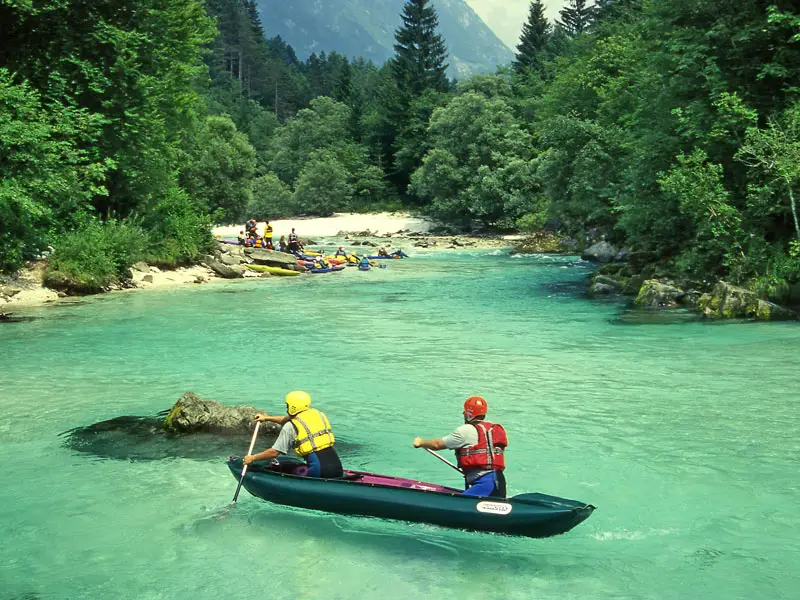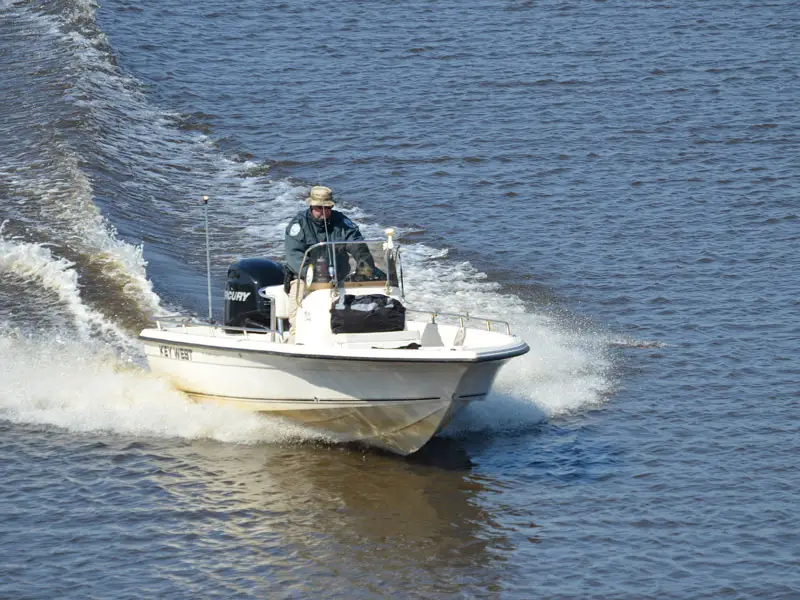Canoeing is a popular water sport that requires determination, physical prowess, and quick reaction times in order to have a safe and enjoyable trip, but is canoeing dangerous? Most of the time, when you see a canoe, it is drifting slowly down the river; however, there are bound to be portions of the river that are rocky and perilous. However, for every danger that hides around the corner, there is a way to avoid them, making the entire voyage downstream safe. If you are wondering how safe canoeing is, I will try to answer that question below.
Canoeing is actually one of the safest water sports when the proper training and precautions are taken. This means wearing the necessary safety equipment and only using your canoe in rivers that are safe for the activity. Some even say that canoes are some of the safest boats on the water. Continue reading to learn all about the hazards when it comes to canoeing and how to maintain your safety on the water.
Is Canoeing Dangerous?
The easiest way I can answer this question is: Yes, canoeing can be dangerous if you don’t take the proper precautions. The first thing anyone should learn is how to maintain their balance. This means doing your first couple of trips on steady, slow moving water with no rocks or obstacles. This will allow you to understand your balance and ensure your safety from the very beginning. Canoes are easy to tip; however, it is also easy to learn proper balance while canoeing. The longer answer is: No, canoeing isn’t dangerous but only if you take the proper precautions and do it the right way.
How to Maintain Balance In A Canoe
To begin, lowering your center of gravity is key. Keeping your weight towards the bottom of the canoe is key to stopping the boat from tipping over. This means keeping your arms down and resisting the urge to raise yourself to shift your body. Always leaning downstream also allows your body to work with the flow of the water, maintaining momentum and balance.
The easiest time to tip over is actually when entering and exiting the canoe. This process is difficult to get down to a science; however, with practice, anyone can enter and exit a canoe safely.
Take Precautions
Failing to prepare is preparing to fail! Although you may not be planning for things to go wrong, sometimes accidents happen. Make sure you are ready for all eventualities.
Wear A Life Jacket or PFD
Never canoe without a personal flotation device. It is a lifesaver. It will allow you to stay afloat should you fall out of the canoe. Helmets are also an option; however, helmets are only necessary if you are boating on rapids – something the beginner should avoid until they are confident in their skills.

Find a personal flotation device that is comfortable and effective. It may take some experimenting, but you will be able to find a PFD that works for you. It is important that your PFD doesn’t restrict your paddling movement.
Let Someone Know
At the very least, always let someone know when you go out canoeing, where you are going, and what time you expect to come back. If you don’t return on time they can alert the authorities. Consider logging a float plan with the authorities, especially if you are planning a longer trip.
Check The Weather
Even if you are canoeing in sheltered lakes and rivers, it is vital that you know what the weather is doing before you set out. Forecasts can be obtained from television or radio, but internet forecasts are now much more detailed and customizable. I use Windy.com which is a great free online forecast.
If you are heading out for a long trip into the wilderness and don’t want to be left in the dark, currently the only option is satellite forecasts. Predict Wind have plans using the Iridium Go satellite system to provide weather forecasts anywhere in the world.
Have Supplies
Don’t go out canoeing without adequate supplies. Apart from your canoe, paddles, and PFD, the bare minimum you need with you for a few hours of canoeing is water, snacks, a first aid kit, cell phone, and appropriate clothing for the weather. For longer trips, you will need much more. Dry bags are also the canoers’ best friend. You can store radios, cell phones, flashlights, and more with a dry bag.
Consider Using Outriggers For Extra Stability
Outriggers will do a lot of the work for you when it comes to balancing. They are optional accessories that you can attach to a canoe. The outriggers attach to each side of a canoe, increasing stability and making it less likely that the boat will tip over.
They are made from a buoyant, lightweight material and work almost the same way as training wheels on a child’s bicycle. Outriggers will make it nearly impossible to tip the canoe over. If you are new to canoeing and worried about capsizing, consider using outriggers until you master your balance.
In our article What Is An Outrigger Canoe, we explain more about the history of the craft that colonized the pacific region.
Common Canoeing Hazards
Anyone wondering “is canoeing dangerous?” should be aware of the common hazards associated with canoeing.
Sudden Change in River Speed
Rivers are volatile. Knowing the river you are going to be canoeing in will educate you enough to know when the harder parts are coming up. Preparing ahead of time is the best way to get through a portion of rough water.
Don’t attempt to navigate rapids that are beyond you or your canoe’s capabilities. You always have the option to “portage,” which is carrying your craft across the land to avoid obstacles or dangers.
Rocks and Branches
Rocks can be a canoers worst enemy. Even if the rocks are not close enough to the service to hit the canoe, a large rock can affect a river’s flow. They can create strong currents that may temporarily throw off the normal flow of the water. Learn how to spot current changes ahead of time and try to avoid them altogether when possible. Currents can be strong enough to turn your canoe sideways, flipping you in the process.
Low hanging branches have knocked over the most skilled canoers. Always be on the lookout for branches that hang too low. Try to avoid them altogether, and be prepared to duck when you can’t manage to navigate your boat away from the tree lines.
Weirs and Head Dams
A weir is a man-made drop in the river’s water. These can create currents that will pull you and your boat underwater. These are even more dangerous than rocks because they are harder to identify. However, you can spot a weir if you are savvy. They are identifiable if you pay attention closely.
Do not attempt to go over weirs or head dams. sometimes there will be a channel in the river around them, if not carry your canoe over land to avoid them.

Cold Water
Falling in cold water can be very dangerous. the initial shock can be enough to cause cardiac arrest in people with heart problems. Besides that, the blood vessels constricting in your skin and muscles can cause a tempoary imobilisation. If you do find yourself in this situation, remain calm, try to float on your back letting your PFD do its job until the feeling has passed before trying to swim.
After being submerged in cold water, hypothermia is a real risk. Have a spare set of dry clothing in a dry bag, and some way to warm yourself up again. Thermal survival blankets are cheap, take little storage space, and can save your life.
If you are canoeing on cold water rapids and suspect that there is a good chance of you going in the water, it would be wise to wear a wetsuit or drysuit.
Other Craft and Water Users
Other people can be more dangerous than anything else you find on the water in many cases. Never assume that others have the same knowledge about canoeing or any other watersport that you do. Always use precaution around others and maintain a safe distance.
The greatest danger is from careless high speed craft. In a canoe you are low down to the water and may not be seen in with a passing glance. Carry a sound signal such as a whistle or air horn to alert others to your presence. If canoeing at night, have clear navigation lights so your location can be seen clearly.

Learn what to do if your Canoe Does Tip
Being prepared is key to canoeing. You will tip over eventually, probably early on in your experience. Water will fill the canoe faster than you’d think. A good idea is to practice in slow-moving water. Tip the canoe over on purpose and watch how the water reacts. Also, try re-entering the canoe when possible. Practicing like this will ensure that you know exactly what to do when your canoe tips over accidentally.
You won’t be able to re-enter the canoe in every situation. You should also plan ahead and know that your canoe will likely be unobtainable once you have flipped over. You will have to swim to shore in most cases. Never try to go for the canoe if you are thrown too far away. Rapidly moving water will separate you from your canoe and paddles quickly. It’s best to put your safety ahead of the safety of your gear and boat.
Stop Your Canoe Sinking With Canoe Float Bags.
Canoe float bags are large chambers of air that you can use to prevent your canoe from completely sinking if you capsize or take on too much water. They are a must have if you are canoeing through rapids. They fit into the bow and stern of your canoe, allowing you to still have space to sit and store your gear. The Palm Canoe Air Bag is designed specifically to fit canoes and is available on Amazon.
Conclusion: Is Canoeing Dangerous?
Like everything in life, it can be. Although, you’ll never learn how to canoe if you keep asking yourself “is canoeing dangerous?” The best thing to do is to hit the water and give it a try for yourself. You’ll find that any watersport can be dangerous, but if you take the proper precautions, start off with small trips, and practice with the correct exercises, canoeing can be one of the safest water sports out there.
Before you canoe somewhere new, you should take the time to learn the river or lake you are going to paddle. Research online, in a book, or ask someone locally. Canoes have been around for thousands of years, so someone will have canoed that area before you.

